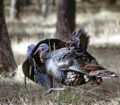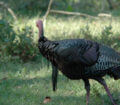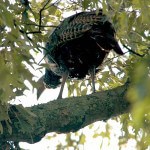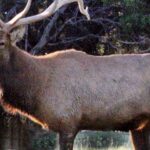John’s Note: Long known as an authority on the wild turkey, Tom Kelly of Spanish Fort, Alabama, has written numerous books about wild turkeys, perhaps the most famous being, “Tenth Legion.” The first time I interviewed Kelly was in the late 1970s, and he was and still is today a fount of turkey information.
 The first thing to remember when you sit down to call a turkey is that you’re trying to get him to perform an unnatural act – going to the hen. In nature, most of the time, the hen will go to the gobbler. So, from the very beginning when you try to call a turkey, you’re at a disadvantage.
The first thing to remember when you sit down to call a turkey is that you’re trying to get him to perform an unnatural act – going to the hen. In nature, most of the time, the hen will go to the gobbler. So, from the very beginning when you try to call a turkey, you’re at a disadvantage.
The turkey-mating program starts in the spring when the ole toms begin to gobble. If you watch turkeys long enough, you know the next thing that usually happens is that the hens start flying down toward a gobbler or running through the woods to him. When a tom has gathered enough hens for his morning activities, he’ll fly down off the roost and walk through the woods with them. He’ll feed along and gobble every now and then. Later in the morning, the hens will start moving away from you with him.
Normally, when an old boss gobbler has his hens with him, and you yelp to him, he’ll gobble back and continue walking away from you with them. I’ve found that if you get up and move closer to him – maybe within 100 yards – and continue to call as he moves away, he’ll begin to notice that you’re there. He’ll gobble back, and you’ll yelp, but he’ll still keep moving off. Every time he moves away from you, continue to slip closer. Every now and then, an older turkey like this will get a notion that he needs to come back to you, gather you up and bring you in with the rest of his hens. And, that’s when you can get him. Even though the turkey has all his hens with him, he starts to believe there’s one more hen he really needs to take into his harem. As long as you follow him, he keeps believing you want to be part of that harem. Later in the day when some of his lady friends have left him, he’ll decide to come back to you. That’s when you take your shot.
 I discovered this tactic through sheer stubbornness and persistence. I just made up my mind that a turkey wasn’t going to walk off and leave me. I was going to trail him through the woods until he came back to get me – if the whole process took 2-3 hours. I’ve learned that the most-difficult thing in the world is to sit flat on your fanny and make a turkey come to you. For that reason, I move a great deal when trying to get a turkey to come within range. I believe that to be a successful turkey hunter, you have to be aggressive and move a lot. If a turkey doesn’t come to you, you’ve got to get ahead of him or to the side of him and make him come to you. This tactic won’t work every time, of course, but nothing else will either.
I discovered this tactic through sheer stubbornness and persistence. I just made up my mind that a turkey wasn’t going to walk off and leave me. I was going to trail him through the woods until he came back to get me – if the whole process took 2-3 hours. I’ve learned that the most-difficult thing in the world is to sit flat on your fanny and make a turkey come to you. For that reason, I move a great deal when trying to get a turkey to come within range. I believe that to be a successful turkey hunter, you have to be aggressive and move a lot. If a turkey doesn’t come to you, you’ve got to get ahead of him or to the side of him and make him come to you. This tactic won’t work every time, of course, but nothing else will either.
Turkeys are easiest to take at the beginning of the spring gobbling season. They haven’t established their gobbling grounds and are just out walking around. When you yelp to a gobbler then, he may run all over you. Of course you only get one gobbler like that every 3-4 years, but this type of bird really refreshes you. You feel you’re doing a good job of yelping when he comes running in to you, but really you aren’t. You’ve just caught one ole boy out with lovemaking on his mind, and you’re available.
A turkey that stops and gobbles in one place regularly will have hens coming to him. They know where to watch for him, and he knows where to expect them. So, when he sounds off in the morning, the hens come to meet him. If you kill one of these gobblers later in the season by following him or using another tactic, two or three mornings afterward you may hear more gobbling in that same place. But don’t worry. It’s not the ghost of that gobbler you’ve taken home to supper. There may be several subdominant gobblers in the area where the old boss gobbler has been. Since the boss gobbler is dominant, he won’t let these others gobble. As long as he’s gobbling, they have two choices – either keep quiet or get whipped. Most of them will choose to keep quiet. But after you’ve killed the boss gobbler, and the younger ones don’t hear him for several mornings, the next gobbler in the pecking order will move into his territory and establish dominance.
Sometimes I’ll go back to an area and take the next turkey in line. In one spring gobbling season, I took three gobblers out of the same acre of woods – which is not unusual, as most veteran turkey hunters will attest. Once you locate a region where turkeys gobble year after year, you can return to that place and kill one just about every year. Depending on the state’s season and bag limits, you sometimes can take two or three turkeys in the same section of land each season.
One of my secrets for successful turkey hunting is to go to an area after listening to some fellow brag about hunting a turkey for 8, 10 or 12 mornings and then finally killing him. Usually the hunter will tell me exactly where he’s killed the turkey, and how. He’ll assume his gobbler has been the only one there, and he’ll be off hunting other areas, trying to find other turkeys. Generally other hunters will avoid a place like this because they know a turkey already has been taken there. When those other hunters assume that, they’ve just opened the door for me to go into that same area and hunt without being disturbed. If hens have been accustomed to meeting a gobbler there, usually when that gobbler is killed, another one will move in to pick them up. Probably I’ll get him too. This tactic is always best at the last of the season when the boss gobblers have already set up their territories and exerted their dominance over the junior gobblers. During the first of the season, when the turkeys are just moving around and haven’t set up territories, this tactic is not nearly as effective.
 Another secret I’ve learned, which most old-time turkey hunters completely disregard, is to listen to wildlife biologists. Two of my favorites are Lovett Williams in Florida and Dan Speake in Alabama, both of whom have retired now but researched turkeys using radiotelemetry. There is so much research being done on turkeys right now, and so much knowledge being gained, that you drastically can improve your turkey hunting by listening to what biologists say about turkey movement and behavior patterns. Most turkey hunters get their information at the barber shop, which usually isn’t worth anything. So, to become a better hunter, listen to the biologists who study turkeys. By putting radios on turkeys, they can track them all year long. The radios are so sensitive the biologists even know when a turkey dies.
Another secret I’ve learned, which most old-time turkey hunters completely disregard, is to listen to wildlife biologists. Two of my favorites are Lovett Williams in Florida and Dan Speake in Alabama, both of whom have retired now but researched turkeys using radiotelemetry. There is so much research being done on turkeys right now, and so much knowledge being gained, that you drastically can improve your turkey hunting by listening to what biologists say about turkey movement and behavior patterns. Most turkey hunters get their information at the barber shop, which usually isn’t worth anything. So, to become a better hunter, listen to the biologists who study turkeys. By putting radios on turkeys, they can track them all year long. The radios are so sensitive the biologists even know when a turkey dies.
To learn more about turkey hunting, check out John E. Phillips’ print, Audible, Kindle and Nook turkey books at https://johninthewild.com/books/#turkey and at www.barnesandnoble.com. You also can download a free Kindle app that enables you to read the book on your iPad, computer or SmartPhone. Too, know more about calling turkeys by going to johninthewild.com/audio-files/ to purchase audio turkey tapes of Lovett Williams, Rob Keck and Chris Kirby, available for download to your SmartPhone, tablet or computer. For a free copy of John E. Phillips’ “The Turkey Gobbler Getter Manual,” go to https://johninthewild.com/free-books/ to download.










